|
|
 |
|
|
 |
 |
For several decades, human factors engineers at NASA Ames Research Center have been on the leading edge of human-centered aerospace research. Below you will find some notable historical achievements of the Human Systems Integration Division and its predecessors.
1960s
Cockpit Simulators |
 |
Ames human factors engineers have been at the forefront of cockpit simulation development. Decades ago, Ames engineers built a human-rated, six-degree-of-freedom simulator for testing rotorcraft. In addition, Ames built a spacecraft cockpit simulator at the end of a centrifuge arm. The rotational speed of the centrifuge created G-forces similar to those experienced during spaceflight launch. This simulator was used for training Apollo astronauts. |
|
1970s
Aviation Safety Reporting System (ASRS) |
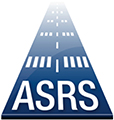 |
Established in 1976, the Aviation Safety Reporting System (ASRS) receives, processes and analyzes voluntarily submitted reports from pilots, air traffic controllers, dispatchers, cabin crew, maintenance technicians, and others. Reports submitted to ASRS may describe both unsafe occurrences and hazardous situations. Information is gathered from these reports and disseminated to stakeholders. A particular focus of ASRS is the quality of human performance in the National Airspace System. More information can be found here. |
 |
| Crew Resource Management (CRM) |
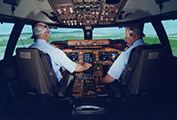 |
Crew Resource Management (CRM) (also called Cockpit Resource Management) is a set of procedures followed by the crew to ensure fundamental human factors principles are employed for safety. CRM originated from a workshop held at NASA Ames Research Center in 1979 in the wake of a fatal commercial crash whose crew members "failed to convey concern about fuel" until the accident was inevitable (according to the National Transportation Safety Board). The NTSB made a recommendation for new training on flightdeck resource management with a focus on participative management for captains and assertiveness training for other crew members. NASA Ames researchers have extensively developed CRM since that recommendation, and CRM training is now broadly employed across commercial and military aviation, medicine and many industries where safety is a priority. |
|
1980s
NASA Task Load Index (TLX) |
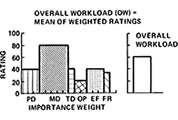 |
The NASA Task Load Index (TLX) is a subjective workload assessment tool to allow users to perform subjective workload assessments on operators working with human-machine interface systems. Originally developed as a paper and pencil questionnaire in the 1980s, NASA TLX has become the gold standard for measuring subjective workload across a wide range of applications. By incorporating a multi-dimensional rating procedure, NASA TLX derives an overall workload score based on a weighted average of ratings on six subscales: mental demand, physical demand, temporal demand, performance, effort and frustration. NASA TLX has been successfully used around the world to assess workload in various environments such as aircraft cockpits, spacecraft cockpits, and controller workstations. In 2017, the Human Systems Integration Division released TLX as an updated and free iOS application on the Apple App Store for the iPhone, iPad, and iPod. This release of TLX not only dramatically increases its accessibility for the research and development community, but also enables mobile and contextual assessments (e.g., in an airplane cockpit during flight, rather than at a desktop computer in a lab). More information can be found here. |
|
1990s
Digital Video Assessment |
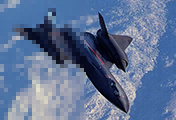 |
The growth of digital video gave rise to a need for computational methods for evaluating the visual quality of digital video. Human factors scientists at NASA's Vision Group developed a new metric to assess digital video sequences. This technique incorporated aspects of human visual processing, including light adaptation, luminance and chromatic channels, spatial and temporal filtering, spatial frequency channels, contrast masking, and probability summation. Scientists applied the metric to digital video sequences corrupted by various typical compression artifacts. Knowledge of the human perception of digital video enabled the development of a method for performing image compression that eliminates invisible image artifacts while maintaining high quality. This technique was patented in 1995. |
|
2000s
Effects of Rocket Vibration |
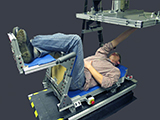 |
During launch of spacecraft, the vibration in the flight deck can so substantial that astronauts may have difficulty reading the information on the displays and may experience additional deficits. As a result, the Human Vibration Laboratory was established to assess whole-body vibration impacts on visual, cognitive, and manual performance, understand the mechanisms contributing to related performance deficits, and develop countermeasures to mitigate these deficits. One solution could be implementing dampers and other physical countermeasures on the rocket. Fortunately, a simpler and less expensive alternative was proposed: strobing the displays in synchronization with the vibration. This technique proved to greatly improve the legibility of cockpit displays during vibration in a simulator, and the technique resulted in a new patent. |
|
2010s
Scheduling |
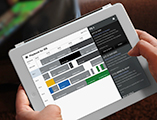 |
NASA space missions, both human and robotic, involve carrying out many activities and procedures every day. As such, special tools are necessary to plan and schedule mission activities, especially during rapid environmental changes. The Human-Computer Interaction Group developed mission planning tools for the Mars Exploration Rovers, Phoenix Mars lander, and Mars Science Laboratory. In addition, the Human-Computer Interaction Group created an advanced scheduling tool (called Score) which became the primary tool for planning astronaut activities on the International Space Station (ISS). With Score, flight controllers at NASA Johnson Space Center and partner space agencies like the European Space Agency (ESA) can use one integrated suite of tools to schedule minute-by-minute or long-term activities. Additionally, flight controllers can access plans remotely and concurrently in real-time, providing a collaborative tool for planners from different NASA centers and international partner locations. Playbook is a notable extension of those previous systems in that it is designed for direct use by the crew on mobile devices (including iPads and iPhones) as well as desktop and laptop computers. It allows the crew and ground team) to view and manipulate timeline mission activities, capture the mission log (along with associated pictures and video) and access procedures for all mission activities. Playbook was designed to require minimal training, and crew use in Earth-analogs so far indicates that this has been very successful. In 2015, its functionality was verified onboard the International Space Station. |
|
|
|